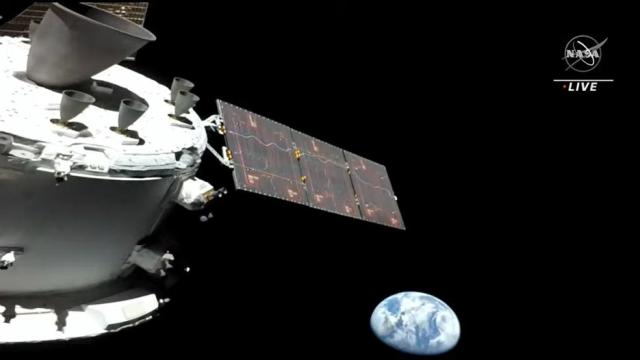NASA’s Artemis 1 mission is in full swing, with the agency’s SLS megarocket blasting off earlier this morning from Kennedy Space Centre in Florida. The freshly launched Orion spacecraft is heading to the Moon, but it captured a sweet view of Earth before saying goodbye.
Orion will travel for 25 days, logging 64,000 kilometres beyond the Moon before returning to Earth. During the first few hours of its trip, Orion captured gorgeous views of our home planet glimmering in a soft shade of blue against the dark backdrop of space.
New views of planet Earth from @NASA_Orion as #Artemis I journeys to the Moon. Orion is 9.5 hours into a 25.5-day test flight. pic.twitter.com/CBaA4ZOK4X
— NASA (@NASA) November 16, 2022
NASA’s Space Launch System (SLS) launched from Florida’s Kennedy Space Centre at 1:47 a.m. ET (5:47 p.m. AEDT) on Wednesday, November 16. About an hour after liftoff, Orion successfully separated from the rocket’s upper stage to initiate its solo trip to the Moon. The spacecraft performed a trans-lunar injection manoeuvre, which propels it on its path to the Moon and accelerates its speed to more than 36,371 km per hour.
Following its separation from the propulsion stage, the Orion capsule began its coast towards the Moon. The spacecraft should reach the Moon by November 22, flying about 100 kilometres above the lunar surface. From there, Orion will use the gravitational force of the Moon to take it on an opposite, looping orbit that extends 70,000 kilometres from the Moon, according to NASA.
Orion has separated from the Interim Cryogenic Propulsion Stage. We’re on our way to the Moon. Go #Artemis! pic.twitter.com/MJuAiECW1H
— Orion Spacecraft (@NASA_Orion) November 16, 2022
For its journey, Orion is equipped with 16 cameras to capture images of the Moon and Earth. The spacecraft has already put its cameras to use, turning back to look at our home planet as it begins its journey to our natural satellite. The photo was captured while Orion was about 93,340 kilometres away from Earth.
For the inaugural Artemis mission, NASA is sending an uncrewed Orion capsule to the Moon and back in anticipation of the space agency landing astronauts on the lunar surface no earlier than 2025. Although there are no people on board Orion, the spacecraft is carrying a manikin nicknamed Commander Moonikin Campos to collect data about flight accelerations and vibrations. Two torsos, Helga and Zohar, are also on board, and they’ll be assessing radiation risks, particularly, for women.
While #Artemis I is uncrewed, a manikin named “Commander Moonikin Campos” is among the test devices flying aboard @NASA_Orion. The name honors NASA engineer Arturo Campos, who helped bring the Apollo 13 crew safely home to Earth. https://t.co/B5x3fSQQ74 pic.twitter.com/2gs2eC7pWi
— NASA (@NASA) November 16, 2022
Orion will return to Earth on December 11, reentering through the atmosphere and splashing down in the Pacific Ocean. Until then, we’ll be closely following the lunar capsule on its journey.
More: NASA’s Moon Rocket Endures Excessive Winds on Its Launchpad in Florida
